The Eiffel Tower ( EYE-fəl; French: Tour Eiffel [tuʁ ɛfɛl] ) is a wrought-iron lattice tower on the Champ de Mars in Paris, France. It is named after the engineer Gustave Eiffel, whose company designed and built the tower from 1887 to 1889.
Locally nicknamed "La dame de fer" (French for "Iron Lady"), it was constructed as the centerpiece of the 1889 World's Fair, and to crown the centennial anniversary of the French Revolution. Although initially criticised by some of France's leading artists and intellectuals for its design, it has since become a global cultural icon of France and one of the most recognisable structures in the world. The tower received 5,889,000 visito...Read more
The Eiffel Tower ( EYE-fəl; French: Tour Eiffel [tuʁ ɛfɛl] ) is a wrought-iron lattice tower on the Champ de Mars in Paris, France. It is named after the engineer Gustave Eiffel, whose company designed and built the tower from 1887 to 1889.
Locally nicknamed "La dame de fer" (French for "Iron Lady"), it was constructed as the centerpiece of the 1889 World's Fair, and to crown the centennial anniversary of the French Revolution. Although initially criticised by some of France's leading artists and intellectuals for its design, it has since become a global cultural icon of France and one of the most recognisable structures in the world. The tower received 5,889,000 visitors in 2022. The Eiffel Tower is the most visited monument with an entrance fee in the world: 6.91 million people ascended it in 2015. It was designated a monument historique in 1964, and was named part of a UNESCO World Heritage Site ("Paris, Banks of the Seine") in 1991.
The tower is 330 metres (1,083 ft) tall, about the same height as an 81-storey building, and the tallest structure in Paris. Its base is square, measuring 125 metres (410 ft) on each side. During its construction, the Eiffel Tower surpassed the Washington Monument to become the tallest human-made structure in the world, a title it held for 41 years until the Chrysler Building in New York City was finished in 1930. It was the first structure in the world to surpass both the 200-metre and 300-metre mark in height. Due to the addition of a broadcasting aerial at the top of the tower in 1957, it is now taller than the Chrysler Building by 5.2 metres (17 ft). Excluding transmitters, the Eiffel Tower is the second tallest free-standing structure in France after the Millau Viaduct.
The tower has three levels for visitors, with restaurants on the first and second levels. The top level's upper platform is 276 m (906 ft) above the ground – the highest observation deck accessible to the public in the European Union. Tickets can be purchased to ascend by stairs or lift to the first and second levels. The climb from ground level to the first level is over 300 steps, as is the climb from the first level to the second, making the entire ascent a 600 step climb. Although there is a staircase to the top level, it is usually accessible only by lift. On this top, third level is a private apartment built for Gustave Eiffel's private use. He decorated it with furniture by Jean Lachaise and invited friends such as Thomas Edison.
The design of the Eiffel Tower is attributed to Maurice Koechlin and Émile Nouguier, two senior engineers working for the Compagnie des Établissements Eiffel. It was envisioned after discussion about a suitable centerpiece for the proposed 1889 Exposition Universelle, a world's fair to celebrate the centennial of the French Revolution. In May 1884, working at home, Koechlin made a sketch of their idea, described by him as "a great pylon, consisting of four lattice girders standing apart at the base and coming together at the top, joined together by metal trusses at regular intervals".[1] Eiffel initially showed little enthusiasm, but he did approve further study, and the two engineers then asked Stephen Sauvestre, the head of the company's architectural department, to contribute to the design. Sauvestre added decorative arches to the base of the tower, a glass pavilion to the first level, and other embellishments.
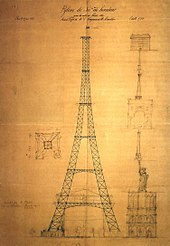 First drawing of the Eiffel Tower by Maurice Koechlin including size comparison with other Parisian landmarks such as Notre Dame de Paris, the Statue of Liberty, and the Vendôme Column
First drawing of the Eiffel Tower by Maurice Koechlin including size comparison with other Parisian landmarks such as Notre Dame de Paris, the Statue of Liberty, and the Vendôme ColumnThe new version gained Eiffel's support: he bought the rights to the patent on the design which Koechlin, Nougier, and Sauvestre had taken out, and the design was put on display at the Exhibition of Decorative Arts in the autumn of 1884 under the company name. On 30 March 1885, Eiffel presented his plans to the Société des Ingénieurs Civils; after discussing the technical problems and emphasising the practical uses of the tower, he finished his talk by saying the tower would symbolise
[n]ot only the art of the modern engineer, but also the century of Industry and Science in which we are living, and for which the way was prepared by the great scientific movement of the eighteenth century and by the Revolution of 1789, to which this monument will be built as an expression of France's gratitude.[2]
Little progress was made until 1886, when Jules Grévy was re-elected as president of France and Édouard Lockroy was appointed as minister for trade. A budget for the exposition was passed and, on 1 May, Lockroy announced an alteration to the terms of the open competition being held for a centrepiece to the exposition, which effectively made the selection of Eiffel's design a foregone conclusion, as entries had to include a study for a 300 m (980 ft) four-sided metal tower on the Champ de Mars.[2] (A 300-metre tower was then considered a herculean engineering effort.) On 12 May, a commission was set up to examine Eiffel's scheme and its rivals, which, a month later, decided that all the proposals except Eiffel's were either impractical or lacking in details.
After some debate about the exact location of the tower, a contract was signed on 8 January 1887. Eiffel signed it acting in his own capacity rather than as the representative of his company, the contract granting him 1.5 million francs toward the construction costs: less than a quarter of the estimated 6.5 million francs. Eiffel was to receive all income from the commercial exploitation of the tower during the exhibition and for the next 20 years. He later established a separate company to manage the tower, putting up half the necessary capital himself.[3]
A French bank, the Crédit Industriel et Commercial (CIC), helped finance the construction of the Eiffel Tower. During the period of the tower's construction, the CIC was acquiring funds from predatory loans to the National Bank of Haiti, some of which went towards the financing of the tower. These loans were connected to an indemnity controversy which saw France force Haiti's government to financially compensate French slaveowners for lost income as a result of the Haitian Revolution, and required Haiti to pay the CIC and its partner nearly half of all taxes collected on exports, "effectively choking off the nation's primary source of income". According to The New York Times, "[at] a time when the [CIC] was helping finance one of the world's best-known landmarks, the Eiffel Tower, as a monument to French liberty, it was choking Haiti's economy, taking much of the young nation's income back to Paris and impairing its ability to start schools, hospitals and the other building blocks of an independent country."[4]
Artists' protest Caricature of Gustave Eiffel comparing the Eiffel tower to the Pyramids, published in Le Temps, 14 February 1887
Caricature of Gustave Eiffel comparing the Eiffel tower to the Pyramids, published in Le Temps, 14 February 1887The proposed tower had been a subject of controversy, drawing criticism from those who did not believe it was feasible and those who objected on artistic grounds. Prior to the Eiffel Tower's construction, no structure had ever been constructed to a height of 300 m, or even 200 m for that matter,[5] and many people believed it was impossible. These objections were an expression of a long-standing debate in France about the relationship between architecture and engineering. It came to a head as work began at the Champ de Mars: a "Committee of Three Hundred" (one member for each metre of the tower's height) was formed, led by the prominent architect Charles Garnier and including some of the most important figures of the arts, such as William-Adolphe Bouguereau, Guy de Maupassant, Charles Gounod and Jules Massenet. A petition called "Artists against the Eiffel Tower" was sent to the Minister of Works and Commissioner for the Exposition, Adolphe Alphand, and it was published by Le Temps on 14 February 1887:
We, writers, painters, sculptors, architects and passionate devotees of the hitherto untouched beauty of Paris, protest with all our strength, with all our indignation in the name of slighted French taste, against the erection ... of this useless and monstrous Eiffel Tower ... To bring our arguments home, imagine for a moment a giddy, ridiculous tower dominating Paris like a gigantic black smokestack, crushing under its barbaric bulk Notre Dame, the Tour Saint-Jacques, the Louvre, the Dome of les Invalides, the Arc de Triomphe, all of our humiliated monuments will disappear in this ghastly dream. And for twenty years ... we shall see stretching like a blot of ink the hateful shadow of the hateful column of bolted sheet metal.[6]
 A calligram by Guillaume Apollinaire
A calligram by Guillaume ApollinaireGustave Eiffel responded to these criticisms by comparing his tower to the Egyptian pyramids: "My tower will be the tallest edifice ever erected by man. Will it not also be grandiose in its way? And why would something admirable in Egypt become hideous and ridiculous in Paris?"[7] These criticisms were also dealt with by Édouard Lockroy in a letter of support written to Alphand, sardonically saying,[8] "Judging by the stately swell of the rhythms, the beauty of the metaphors, the elegance of its delicate and precise style, one can tell this protest is the result of collaboration of the most famous writers and poets of our time", and he explained that the protest was irrelevant since the project had been decided upon months before, and construction on the tower was already under way.
Indeed, Garnier was a member of the Tower Commission that had examined the various proposals, and had raised no objection. Eiffel was similarly unworried, pointing out to a journalist that it was premature to judge the effect of the tower solely on the basis of the drawings, that the Champ de Mars was distant enough from the monuments mentioned in the protest for there to be little risk of the tower overwhelming them, and putting the aesthetic argument for the tower: "Do not the laws of natural forces always conform to the secret laws of harmony?"[9]
Some of the protesters changed their minds when the tower was built; others remained unconvinced.[10] Guy de Maupassant supposedly ate lunch in the tower's restaurant every day because it was the one place in Paris where the tower was not visible.[11]
By 1918, it had become a symbol of Paris and of France after Guillaume Apollinaire wrote a nationalist poem in the shape of the tower (a calligram) to express his feelings about the war against Germany.[12] Today, it is widely considered to be a remarkable piece of structural art, and is often featured in films and literature.
Construction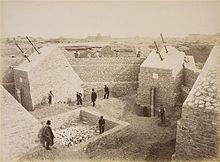 Foundations of the Eiffel Tower, photographed in 1887
Foundations of the Eiffel Tower, photographed in 1887Work on the foundations started on 28 January 1887.[13] Those for the east and south legs were straightforward, with each leg resting on four 2 m (6.6 ft) concrete slabs, one for each of the principal girders of each leg. The west and north legs, being closer to the river Seine, were more complicated: each slab needed two piles installed by using compressed-air caissons 15 m (49 ft) long and 6 m (20 ft) in diameter driven to a depth of 22 m (72 ft)[14] to support the concrete slabs, which were 6 m (20 ft) thick. Each of these slabs supported a block of limestone with an inclined top to bear a supporting shoe for the ironwork.
Each shoe was anchored to the stonework by a pair of bolts 10 cm (4 in) in diameter and 7.5 m (25 ft) long. The foundations were completed on 30 June, and the erection of the ironwork began. The visible work on-site was complemented by the enormous amount of exacting preparatory work that took place behind the scenes: the drawing office produced 1,700 general drawings and 3,629 detailed drawings of the 18,038 different parts needed.[15] The task of drawing the components was complicated by the complex angles involved in the design and the degree of precision required: the position of rivet holes was specified to within 1 mm (0.04 in) and angles worked out to one second of arc.[16] The finished components, some already riveted together into sub-assemblies, arrived on horse-drawn carts from a factory in the nearby Parisian suburb of Levallois-Perret and were first bolted together, with the bolts being replaced with rivets as construction progressed. No drilling or shaping was done on site: if any part did not fit, it was sent back to the factory for alteration. In all, 18,038 pieces were joined using 2.5 million rivets.[13]
At first, the legs were constructed as cantilevers, but about halfway to the first level construction was paused to create a substantial timber scaffold. This renewed concerns about the structural integrity of the tower, and sensational headlines such as "Eiffel Suicide!" and "Gustave Eiffel Has Gone Mad: He Has Been Confined in an Asylum" appeared in the tabloid press.[17] Multiple famous artists of that time, Charles Garnier and Alexander Dumas, thought poorly of the newly made tower. Charles Garnier thought it was a "truly tragic street lamp". Alexander Dumas said that it was like "Odius shadow of the odious column built of rivets and iron plates extending like a black blot". There were multiple protests over the style and the reasoning of placing it in the middle of Paris.[18] At this stage, a small "creeper" crane designed to move up the tower was installed in each leg. They made use of the guides for the lifts which were to be fitted in the four legs. The critical stage of joining the legs at the first level was completed by the end of March 1888.[13] Although the metalwork had been prepared with the utmost attention to detail, provision had been made to carry out small adjustments to precisely align the legs; hydraulic jacks were fitted to the shoes at the base of each leg, capable of exerting a force of 800 tonnes, and the legs were intentionally constructed at a slightly steeper angle than necessary, being supported by sandboxes on the scaffold. Although construction involved 300 on-site employees,[13] due to Eiffel's safety precautions and the use of movable gangways, guardrails and screens, only one person died.[19]

The start of the erection of the metalwork

Construction of the legs with scaffolding
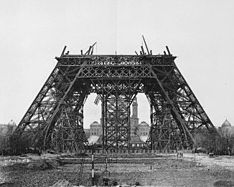
Completion of the first level

Start of construction on the second stage

Completion of the second level

Construction of the upper stage

Construction of the cupola
 View of the 1889 World's Fair
View of the 1889 World's FairThe main structural work was completed at the end of March 1889 and, on 31 March, Eiffel celebrated by leading a group of government officials, accompanied by representatives of the press, to the top of the tower.[10] Because the lifts were not yet in operation, the ascent was made by foot, and took over an hour, with Eiffel stopping frequently to explain various features. Most of the party chose to stop at the lower levels, but a few, including the structural engineer, Émile Nouguier, the head of construction, Jean Compagnon, the President of the City Council, and reporters from Le Figaro and Le Monde Illustré, completed the ascent. At 2:35 pm, Eiffel hoisted a large Tricolour to the accompaniment of a 25-gun salute fired at the first level.[20]
There was still work to be done, particularly on the lifts and facilities, and the tower was not opened to the public until nine days after the opening of the exposition on 6 May; even then, the lifts had not been completed. The tower was an instant success with the public, and nearly 30,000 visitors made the 1,710-step climb to the top before the lifts entered service on 26 May.[21] Tickets cost 2 francs for the first level, 3 for the second, and 5 for the top, with half-price admission on Sundays,[22] and by the end of the exhibition there had been 1,896,987 visitors.[23]
After dark, the tower was lit by hundreds of gas lamps, and a beacon sent out three beams of red, white and blue light. Two searchlights mounted on a circular rail were used to illuminate various buildings of the exposition. The daily opening and closing of the exposition were announced by a cannon at the top.[citation needed]
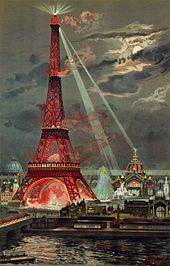 Illumination of the tower at night during the exposition; painted by Georges Garen, 1889
Illumination of the tower at night during the exposition; painted by Georges Garen, 1889On the second level, the French newspaper Le Figaro had an office and a printing press, where a special souvenir edition, Le Figaro de la Tour, was made. There was also a pâtisserie.[citation needed]
At the top, there was a post office where visitors could send letters and postcards as a memento of their visit. Graffitists were also catered for: sheets of paper were mounted on the walls each day for visitors to record their impressions of the tower. Gustave Eiffel described the collection of responses as "truly curious".[24]
Famous visitors to the tower included the Prince of Wales, Sarah Bernhardt, "Buffalo Bill" Cody (his Wild West show was an attraction at the exposition) and Thomas Edison.[21] Eiffel invited Edison to his private apartment at the top of the tower, where Edison presented him with one of his phonographs, a new invention and one of the many highlights of the exposition.[25] Edison signed the guestbook with this message:
To M Eiffel the Engineer the brave builder of so gigantic and original specimen of modern Engineering from one who has the greatest respect and admiration for all Engineers including the Great Engineer the Bon Dieu, Thomas Edison.
Eiffel made use of his apartment at the top of the tower to carry out meteorological observations, and also used the tower to perform experiments on the action of air resistance on falling bodies.[26]
Subsequent events Panoramic view during ascent of the Eiffel Tower by the Lumière brothers, 1898Eiffel had a permit for the tower to stand for 20 years. It was to be dismantled in 1909, when its ownership would revert to the City of Paris. The city had planned to tear it down (part of the original contest rules for designing a tower was that it should be easy to dismantle) but as the tower proved to be valuable for many innovations in the early 20th century, particularly radio telegraphy, it was allowed to remain after the expiry of the permit, and from 1910 it also became part of the International Time Service.[27]
For the 1900 Exposition Universelle, the lifts in the east and west legs were replaced by lifts running as far as the second level constructed by the French firm Fives-Lille. These had a compensating mechanism to keep the floor level as the angle of ascent changed at the first level, and were driven by a similar hydraulic mechanism as the Otis lifts, although this was situated at the base of the tower. Hydraulic pressure was provided by pressurised accumulators located near this mechanism.[28] At the same time the lift in the north pillar was removed and replaced by a staircase to the first level. The layout of both first and second levels was modified, with the space available for visitors on the second level. The original lift in the south pillar was removed 13 years later.[citation needed]
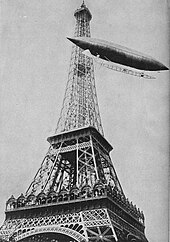 Santos-Dumont No. 5; 13 July 1901
Santos-Dumont No. 5; 13 July 1901On 19 October 1901, Alberto Santos-Dumont, flying his No.6 airship, won a 100,000-franc prize offered by Henri Deutsch de la Meurthe for the first person to make a flight from St. Cloud to the Eiffel Tower and back in less than half an hour.[29]
In 1910, Father Theodor Wulf measured radiant energy at the top and bottom of the tower. He found more at the top than expected, incidentally discovering what are known today as cosmic rays.[30] Two years later, on 4 February 1912, Austrian tailor Franz Reichelt died after jumping from the first level of the tower (a height of 57 m) to demonstrate his parachute design.[31] In 1914, at the outbreak of World War I, a radio transmitter located in the tower jammed German radio communications, seriously hindering their advance on Paris and contributing to the Allied victory at the First Battle of the Marne.[32] From 1925 to 1934, illuminated signs for Citroën adorned three of the tower's sides, making it the tallest advertising space in the world at the time.[33] In April 1935, the tower was used to make experimental low-resolution television transmissions, using a shortwave transmitter of 200 watts power. On 17 November, an improved 180-line transmitter was installed.[34]
 The Eiffel Tower has been a subject of art, as in this cubist painting by Robert Delaunay (1911)
The Eiffel Tower has been a subject of art, as in this cubist painting by Robert Delaunay (1911)On two separate but related occasions in 1925, the con artist Victor Lustig "sold" the tower for scrap metal.[35] A year later, in February 1926, pilot Leon Collet was killed trying to fly under the tower. His aircraft became entangled in an aerial belonging to a wireless station.[36] A bust of Gustave Eiffel by Antoine Bourdelle was unveiled at the base of the north leg on 2 May 1929.[37] In 1930, the tower lost the title of the world's tallest structure when the Chrysler Building in New York City was completed.[38] In 1938, the decorative arcade around the first level was removed.[39]
Upon the German occupation of Paris in 1940, the lift cables were cut by the French. The tower was closed to the public during the occupation and the lifts were not repaired until 1946.[40] In 1940, German soldiers had to climb the tower to hoist a swastika-centered Reichskriegsflagge,[41] but the flag was so large it blew away just a few hours later, and was replaced by a smaller one.[42] When visiting Paris, Hitler chose to stay on the ground. When the Allies were nearing Paris in August 1944, Hitler ordered General Dietrich von Choltitz, the military governor of Paris, to demolish the tower along with the rest of the city. Von Choltitz disobeyed the order.[43] On 25 August, before the Germans had been driven out of Paris, the German flag was replaced with a Tricolour by two men from the French Naval Museum, who narrowly beat three men led by Lucien Sarniguet, who had lowered the Tricolour on 13 June 1940 when Paris fell to the Germans.[40]
A fire started in the television transmitter on 3 January 1956, damaging the top of the tower. Repairs took a year, and in 1957, the present radio aerial was added to the top.[44] In 1964, the Eiffel Tower was officially declared to be a historical monument by the Minister of Cultural Affairs, André Malraux.[45] A year later, an additional lift system was installed in the north pillar.[46]
According to interviews, in 1967, Montreal Mayor Jean Drapeau negotiated a secret agreement with Charles de Gaulle for the tower to be dismantled and temporarily relocated to Montreal to serve as a landmark and tourist attraction during Expo 67. The plan was allegedly vetoed by the company operating the tower out of fear that the French government could refuse permission for the tower to be restored in its original location.[47]
In 1982, the original lifts between the second and third levels were replaced after 97 years in service. These had been closed to the public between November and March because the water in the hydraulic drive tended to freeze. The new cars operate in pairs, with one counterbalancing the other, and perform the journey in one stage, reducing the journey time from eight minutes to less than two minutes. At the same time, two new emergency staircases were installed, replacing the original spiral staircases. In 1983, the south pillar was fitted with an electrically driven Otis lift to serve the Jules Verne restaurant.[citation needed] The Fives-Lille lifts in the east and west legs, fitted in 1899, were extensively refurbished in 1986. The cars were replaced, and a computer system was installed to completely automate the lifts. The motive power was moved from the water hydraulic system to a new electrically driven oil-filled hydraulic system, and the original water hydraulics were retained solely as a counterbalance system.[46] A service lift was added to the south pillar for moving small loads and maintenance personnel three years later.[citation needed]
Robert Moriarty flew a Beechcraft Bonanza under the tower on 31 March 1984.[48] In 1987, A. J. Hackett made one of his first bungee jumps from the top of the Eiffel Tower, using a special cord he had helped develop. Hackett was arrested by the police.[49] On 27 October 1991, Thierry Devaux, along with mountain guide Hervé Calvayrac, performed a series of acrobatic figures while bungee jumping from the second floor of the tower. Facing the Champ de Mars, Devaux used an electric winch between figures to go back up to the second floor. When firemen arrived, he stopped after the sixth jump.[50]
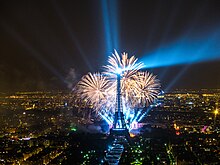 The tower is the focal point for New Year's Eve and Bastille Day (as in this image from 2013) celebrations.
The tower is the focal point for New Year's Eve and Bastille Day (as in this image from 2013) celebrations.For its "Countdown to the Year 2000" celebration on 31 December 1999, flashing lights and high-powered searchlights were installed on the tower. During the last three minutes of the year, the lights were turned on starting from the base of the tower and continuing to the top to welcome 2000 with a huge fireworks show. An exhibition above a cafeteria on the first floor commemorates this event. The searchlights on top of the tower made it a beacon in Paris's night sky, and 20,000 flashing bulbs gave the tower a sparkly appearance for five minutes every hour on the hour.[51]
The lights sparkled blue for several nights to herald the new millennium on 31 December 2000. The sparkly lighting continued for 18 months until July 2001. The sparkling lights were turned on again on 21 June 2003, and the display was planned to last for 10 years before they needed replacing.[52]
The tower received its 200,000,000th guest on 28 November 2002.[53] The tower has operated at its maximum capacity of about 7 million visitors per year since 2003.[54] In 2004, the Eiffel Tower began hosting a seasonal ice rink on the first level.[55] A glass floor was installed on the first level during the 2014 refurbishment.[56]





















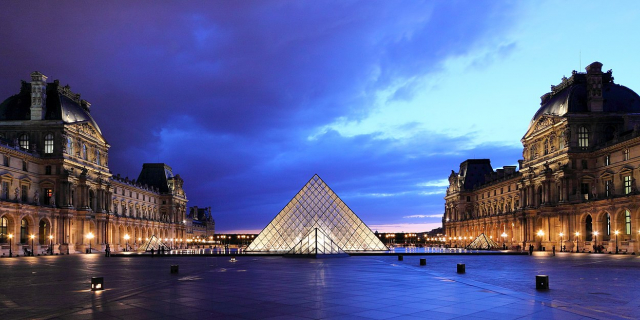










Add new comment